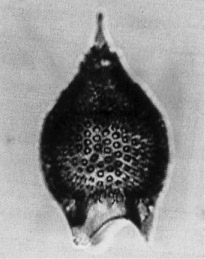 Theocotylissa
alpha Foreman
Theocotylissa
alpha Foreman Theocotylissa
alpha Foreman
Theocotylissa
alpha ForemanTheocotyle (Theocotylissa) alpha Foreman, 1973, p.441, pl.4, figs.13-15 (non 14), pl.12, fig.16; Foreman, 1975, p.621; Sanfilippo and Riedel, 1982, p.179, pl.2, figs.16-17 (with synonymy)
Cephalis subspherical, with no or few small pores, and bearing stout conical horn of about the same length to twice the length. Thorax conical. Lumbar stricture indistinct or not expressed externally. Abdomen longer than thorax, barrel-shaped or subcylindrical. Wall of abdomen and thorax thick, with regularly arranged pores (longitudinally aligned on abdomen) only slightly smaller on thorax. Flat peristome (thicker than in T. auctor) bears three undulations or short, triangular feet, blunt or in some specimens bearing an outward thorn (Sanfilippo and Riedel, 1982).
Based on 20 specimens. Maximum length excluding horn 135-225 µm, of abdomen including feet 85-160 µm. Maximum width 110-145 µm (Sanfilippo and Riedel, 1982).
T. alpha differs from T. auctor (Foreman, 1973, p.441, pl.4, fig.8, non 9-10), pl.12, fig.13) in not having a distinct lumbar stricture and in the abdomen usually more inflated, and from T. ficus in possessing feet and a less conical shape (Sanfilippo et al., 1985).
This barrel-shaped or subcylindrical species has a thick wall, with the lumbar stricture indistinct or only slightly expressed externally. The pores tend to be longitudinally aligned on the abdomen. The thick poreless peristome bears three undulations or short, triangular feet, blunt or in some specimens bearing an outward thorn (Sanfilippo et al., 1985).
T. alpha is found in the tropical Indian and Pacific Oceans, in the Gulf of Mexico and the Caribbean, in middle early Eocene assemblages. Its evolutionary transition from Theocotylissa auctor lies within the Bekoma bidartensis Zone. Its evolutionary transition to Theocotylissa ficus lies within the Buryella clinata Zone.
T. alpha is the intermediate form in the lineage leading from T. auctor to T. ficus.
Additional illustrations can be found in Foreman, 1973, pl.4, figs.9-10 (as T. auctor).
The definition of this species [has been] modified in that the distinction from T. auctor is now based on the outer expression of the lumbar stricture, rather than on abdominal length and size of horn. This change has caused some re-identification of figured specimens (Sanfilippo and Riedel, 1982).